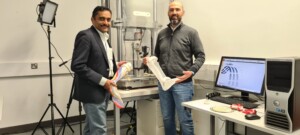Research
Evidence-based guidelines for the optimal design of rigid ankle-foot orthosis
An Ankle-Foot Orthosis (AFO) provides external support for patients with a weakness in the ankle dorsiflexor or plantarflexor muscles caused by conditions such as a stroke, cerebral palsy, spinal cord injury, and peripheral nerve injury. Despite the widespread use of AFOs, there is a lack of standardisation governing both their manufacture and prescription. The thickness of materials used, and the design of reinforcing features by individual manufacturers, can significantly affect their rigidity. This lack of standardisation means that the selection of an AFO is based largely on subjective factors and anecdotal evidence, which has implications for both clinical and cost-effectiveness.

Computational models have been developed to measure the effect of material thickness and reinforcement design on stiffness. This research project aims to translate this lab-based research into clinical practice. According to Professor Nachiappan Chockalingam, Professor of Clinical Biomechanics, at the Centre for Biomechanics and Rehabilitation Technologies, at Staffordshire University, ‘We can construct experiments in a controlled lab environment and show that they work, but if we can make them work in a clinical environment using real as opposed to mathematical data, we can translate it into a prescription process.’
The first stage of the project is to systematically map the variability within manufacturing process, especially the thickness and rigidity of the materials that are used by different companies and the ways in which their technicians thermoform the polypropylene. This will allow the creation of a standardised model for manufacturers and clear guidelines for orthotists and orthotic technicians working anywhere in the world, based on the actual stiffness characteristics of different parts of the AFO.